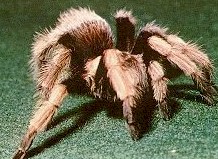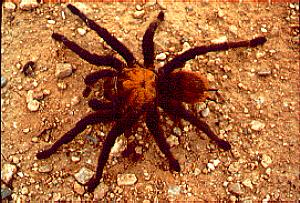

Have you ever heard of a Theraphosid? If
so, then you will know that Therophosids is the scientific name for tarantulas. A
tarantula is like a large spider with rough hair and big fangs. They are classified in a
group of "bugs" called arachnids. Arachnids include spiders, scorpions, ticks,
and mites. Over seven hundred species of tarantulas
have been found, most of them living in jungles and deserts.
seven hundred species of tarantulas
have been found, most of them living in jungles and deserts.
The largest tarantula in the world, a Goliath Bird-eating Spider, measures as large as a frisbee! It is found in South America, where its diet includes small birds, mammals, reptiles, and insects. Although its immense size gives the Goliath a powerful appearance, the venom from this enormous spider is not poisonous enough to damage a human.
Did you know that all tarantulas have hollow fangs? The cavity inside the fang holds venom, which is released when the animal is scared. Only two tarantulas in the United States have poison powerful enough to kill a human being.
 Female tarantulas
lay up to seven hundred eggs. She will guard them fiercely until her children are hatched.
Spiderlings are born with the instinct to hunt, which they will do at one week of age. It
takes between two and twelve years for a tarantula to become fully grown, but females are
lifelong friends. They have been known to live over thirty years.
Female tarantulas
lay up to seven hundred eggs. She will guard them fiercely until her children are hatched.
Spiderlings are born with the instinct to hunt, which they will do at one week of age. It
takes between two and twelve years for a tarantula to become fully grown, but females are
lifelong friends. They have been known to live over thirty years.